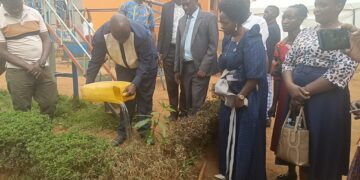Uganda’s coffee export earnings rose sharply in the year ending April 2025, reaching 1.97 billion US dollars. This marked an increase of almost 95 percent from the 1.01 billion dollars recorded in the previous year, which ran from May 2023 to April 2024. The surge was largely driven by higher international coffee prices, though export volumes also increased.
According to the Ministry of Agriculture, Animal Industry and Fisheries, Uganda exported a total of 7.17 million bags of coffee between May 2024 and April 2025. Each bag weighed 60 kilograms. This was a 21.7 percent increase from the 5.9 million bags exported during the same period the previous year.
In April 2025 alone, monthly exports stood at 694,318 bags. This represented a 77.44 percent increase compared to April 2024. The revenue generated from these exports reached 214.38 million dollars, which was 152.56 percent higher than what was earned in the same month of the previous year.
The rise in global coffee prices is being attributed to a decline in supply from major producing countries, especially Brazil and Vietnam. These nations have been affected by unfavorable weather, leading to reduced output and limited exports. As a result, Uganda has benefited from the higher prices on the global market.
In April 2025, Uganda’s coffee sold for an average of 5.15 dollars per kilogram. This was a slight increase from 5.14 dollars in March but a significant jump from 3.62 dollars in April 2024. Among the different types, sustainable Arabica fetched the highest price at 8.70 dollars per kilogram.
The increase in export volumes during April was largely due to a strong harvest from the Masaka and Southwestern regions. On the domestic front, farmers received good prices for their produce. Robusta Kiboko was sold at 7,200 shillings per kilogram at farm-gate level. Fair Average Quality Robusta sold for 14,500 shillings per kilogram. Arabica parchment was priced at 14,800 shillings per kilogram while Drugar fetched 14,000.
A total of 75 companies participated in the coffee export business during the month. However, just 10 of them accounted for 68.43 percent of the total volumes. Robusta coffee continued to dominate, with 594,188 bags exported, generating 177.08 million dollars. Arabica exports totaled 100,130 bags and brought in 37.30 million dollars.
Compared to April 2024, the volume of Robusta exports grew by 104.63 percent, and the value rose by 187.61 percent. On the other hand, Arabica exports saw a slight drop of 0.8 percent in quantity, but their value increased by 60 percent.
Italy remained the leading market for Uganda’s coffee in April 2025, taking in 42.02 percent of the exports. This was up from 38.43 percent in the previous month. Germany followed with 11.3 percent, rising from 6.89 percent, while Spain’s share grew to 7.46 percent from 6.06 percent.
Other notable destinations included India and Sudan, although both recorded a decrease in market share. The growing dominance of the European Union as a key market for Uganda’s coffee has raised concerns over the upcoming EU Deforestation Regulations, which are set to take effect after December 31 this year. These regulations may potentially impact Uganda’s access to the EU market.
Meanwhile, coffee exports to African countries reached 76,467 bags in April, representing an 11 percent share. This was up from 69,052 bags the previous month. African buyers included Sudan, Algeria, Morocco, Egypt, Tunisia, Kenya, Tanzania, and South Africa.
Uganda’s strong performance in coffee exports highlights both the country’s potential in the global coffee market and the challenges it may face from shifting international trade rules and environmental standards.
































